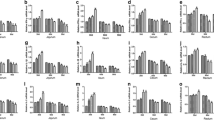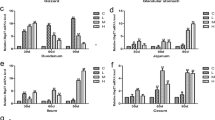Abstract
Exposure of people and animals to arsenic (As) is a global public health concern because As is widely distributed and associated with numerous adverse effects. As is a poisonous metalloid and arsenic trioxide (As2O3) is a form of As. Thus far, there have been very few reports on the inflammatory factor alterations of the gastrointestinal tract in birds exposed to As2O3. To investigate the possible correlation of As2O3 with inflammatory injury induced by an arsenic-supplemented diet in birds, 72 1-day-old male Hy-line cocks were selected and randomly divided into four groups. They were fed with either a commercial diet or an arsenic-supplemented diet containing 7.5, 15, and 30 mg/kg As2O3. The experiment lasted for 90 days, and samples of gizzard, glandular stomach, duodenum, jejunum, ileum, cecum, and rectum were collected at days 30, 60, and 90 of the experiment period. The inflammation-related genes were determined, including NF-κB, iNOS, COX-2, PTGEs, and TNF-α. The connection between arsenic dosage and inflammation-related genes was assessed. The content of inducible NO synthase (iNOS) was measured by Western blot of the samples. The results showed that arsenic supplementation increased the mRNA expression levels of inflammation-related genes in the gastrointestinal tract of cocks at different time points (p < 0.05). Moreover, the expression of the tissue and organ injury-related gene iNOS was upregulated (p < 0.05). These data suggest that As induces the inflammatory response and may trigger digestive function regression of the gastrointestinal tract by affecting inflammation-related genes and iNOS in cocks. This study offers some information on the mechanism of gastrointestinal tract inflammatory injury and iNOS expression level alterations induced by arseniasis.







Similar content being viewed by others
References
Kazi TG, Shah AQ, Afridi HI et al (2013) Hazardous impact of organic arsenical compounds in chicken feed on different tissues of broiler chicken and manure. Ecotox Environ Saf 87:120–123
Dangleben NL, Skiblola CF, Smith MT (2013) Arsenic immunotoxicity: a review. Environ Health 12:73
Nordstrom DK (2002) Worldwide occurrences of arsenic in ground water. Public Health 296:2143–2145
Gochfeld M (1995) Chemical agents. In: Environmental medicine. St. Louis: Mosby, pp 592–614
Cervantes C, Ji G, Ramirez JL et al (1994) Resistance to arsentic compounds in microorganisms. FEMS Microbiol Rev 15:355–367
Gebel T (2000) Confounding variables in the environmental toxicology of arsenic. Toxicology 144:155–162
Ahmad S, Kitchin KT, Cullen WR (2000) Arsenic species that cause release of iron from ferritin and generation of activated oxygen. Arch Biochem Biophys 382:195–202
Squibb KS, Fowler BA (1983) The toxicity of arsenic and its compounds. In: Fowler BA (ed) Biological and environmental effects of arsenic, chap 7. Elsevier Science Publishers, Amsterdam7, pp 233–269
Lawrence T, Gilroy DW, Colville-Nash PR et al (2001) Possible new role for NF-kappaB in the resolution of inflammation. Nat Med 7:1291–1297
Bulbul A, Bulbul T, Sevimli A et al (2013) The effect of dietary supplementation of nitric oxide donor and inhibitor on iNOS expression in and motility of the small intestine of broilers. Biotech Histochem 88(5):258–266
Fiocchi C (1998) Inflammatory bowel disease: etiology and pathogenesis. Gastroenterology 115:182–205
Tanabe T, Tohnai N (2002) Cyclooxygenase isozymes and their gene structures and expression. Prostaglandins Other Lipid Mediat 68–69:95–114
Liu T, Laidlaw TM, Feng C et al (2012) Prostaglandin E2 deficiency uncovers a dominant role for thromboxane A2 in house dust mite-induced allergic pulmonary inflammation. Proc Natl Acad Sci 109:12692–12697
Raabe T, Bukrinsky M, Currie RA (1998) Relative contribution of transcription and translation to the induction of tumor necrosis factor-alpha by lipopolysaccharide. J BIOL CHEM 273:974–980
Peirson SN, Butler JN, Foster RG (2003) Experimental validation of novel and conventional approaches to quantitative real-time PCR data analysis. Nucleic Acids Res 31:e73
Livak KJ, Schmittgen TD (2001) Analysis of relative gene expression data using real-time quantitative PCR and the 2(−Delta Delta C(T)) method. Methods 25:402–408
Webb JL (1966) Enzymes and metabolic inhibitors. Academic, New York, pp 595–793
Xu GL, Hong SY, Song HB et al (1985) Keshan disease and selenium deficiency. Nutr Res 1:187
Nagaraju K, Casciola-Rosen L, Lundberg I et al (2005) Activation of the endoplasmic reticulum stress response in autoimmune myositis: potential role in muscle fiber damage and dysfunction. Arthritis Rheum 52:1824–1835
Wu Q, Yao HD, Tan S et al (2014) Possible correlation of selenoprotein W with inflammation factors in chicken skeletal muscles. Biol Trace Elem Res 161:167–172
Renard P, Raes M (1999) The proinflammatory transcription factor NF-kappa B: a potential target for novel therapeutical strategies. Cell Biol Toxicol 15:341–344
Baldwin AS (1996) The NF-kappa B and I kappa B proteins: new discoveries and insights. Annu Rev Immunol 14:649–683
Makarov SS (2000) NF-kappa B as a therapeutic target in chronic inflammation: recent advances. Mol Med Today 6:441–448
Li J, Qua J, Xu S et al (2013) Avermectin induced inflammation damage in king pigeon brain. Chemosphere 93:2528–2534
Vichai V, Suyarnsesthakorn C, Pittayakhajonwut D et al (2005) Positive feedback regulation of COX-2 expression by prostaglandin metabolites. Inflamm Res 54:163–172
Fu J, Liu CP, Zhang ZW et al (2013) Effects of acute and chronic cold stress on expression of cyclooxygenase-2 and prostaglandin E synthase mRNA in quail intestine. Pak Vet J 33(3):358–363
MacMicking J, Xie QW, Nathan C (1997) Nitric oxide and macrophage function. Annu Rev Immunol 15:323–350
Dubois RN, Abramson SB, Crofford L et al (1998) Cyclooxygenase in biology and disease. FASEB J 12:1063–1073
Freire-Moar J, Sigal E, Chu CQ (19960 Expression of cyclooxygenase-2 in human and an animal model of rheumatoid arthritis. Br J Rheumatol 35:711–718
Kubatka P, Ahlers I, Ahlersova E et al (2003) Chemoprevention of mammary carcinogenesis in female rats by rofecoxib. Cancer Lett 202:131–136
Liu T, Laidlaw TM, Feng C et al (2012) Prostaglandin E2 deficiency uncovers a dominant role for thromboxane A2 in house dust mite-induced allergic pulmonary inflammation. Proc Natl Acad Sci 109:12692–12697
Yang D, Elner SG, Bian ZM et al (2007) Pro-inflammatory cytokines increase reactive oxygen species through mitochondria and NADPH oxidase in cultured RPE cells. Exp Eye Res 85:462–472
Jeremy S, Solis DM, Nakra N et al (2013) Small intestine inflammation in roquin-mutant and roquin-deficient mice. PLoS ONE 8:2
Acknowledgments
This study was supported by the Postdoctoral Scientific-Research Developmental Foundation of Heilongjiang Province (Grant No. LBH-Q13012). We thank American Journal Experts company for the assistance with the English in this manuscript.
Conflict of Interest
None of the authors have any financial or personal relationships that could inappropriately influence or bias the content of the paper.
Author information
Authors and Affiliations
Corresponding authors
Rights and permissions
About this article
Cite this article
Xing, M., Zhao, P., Guo, G. et al. Inflammatory Factor Alterations in the Gastrointestinal Tract of Cocks Overexposed to Arsenic Trioxide. Biol Trace Elem Res 167, 288–299 (2015). https://doi.org/10.1007/s12011-015-0305-8
Received:
Accepted:
Published:
Issue Date:
DOI: https://doi.org/10.1007/s12011-015-0305-8




